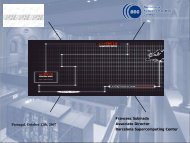e-Infrastructures Roadmap - Internet Society Nederland
e-Infrastructures Roadmap - Internet Society Nederland
e-Infrastructures Roadmap - Internet Society Nederland
- No tags were found...
You also want an ePaper? Increase the reach of your titles
YUMPU automatically turns print PDFs into web optimized ePapers that Google loves.
e-<strong>Infrastructures</strong> <strong>Roadmap</strong>Directions to: Supercomputer infrastructures for EuropeLarge computing facilities come in two flavours: capacity computing and capability computing.Capacity computing typically fills the needs of scientific disciplines which do not need a low-latency,high-bandwidth interconnect architecture between processors. Prices for such capacity facilitiescontinue to drop, and it is not expected that combining these national resources into a few capacitysuper clusters in Europe will benefit from the economy of scale. Surely there exists a need for largecluster facilities, but these tend to fall well within the financial possibilities of users themselves.Capability computing, on the other hand, needs a European approach. In general capacity computingrequires access to many processors in parallel, large memory, and low-latency, high-bandwidthinterconnects. The availability of significantly larger capability systems than available now is urgentlyrequired for increasing the scientific opportunities for many application areas, since more processors andmemory will be available in a low-latency, high-bandwidth interconnect architecture. Hence, the availabilityof a number of capability systems will facilitate economically important fields of science and research inEurope in their efforts of running increasingly accurate simulations. Within the class of capability systems,there are still trade-offs to be made. Actual architectures range from purely shared memory vectorcomputers, through clusters of SMP systems (connected by state-of-the-art interconnects, like Infiniband)to NUMA systems, with a large amount of processors with direct access to a single address space.Since specific application areas run more efficiently on specific capability architectures, it may bedesirable to represent these types of systems in a European Supercomputer infrastructure.Next turnY Perform gap analysis on missing classes of supercomputers architectures.Y Design a robust distribution of facilities across Europe, safeguarding against large scale (natural)disasters.Y Send out a Request for Proposals for the provision of shared European supercomputers.Y Align funding policies for Research <strong>Infrastructures</strong> among European partners to enable bettershared use of resources.End destinationY Continuous and secured provision of state of the art computing facilities from all importantarchitectures available to European Scientists.Directions to: European storage facilitiesEurope can profit from having a shared approach to the increasing storage needs and possibilities byestablishing a distributed shared network of large storage facilities. Complementary to the supercomputersand the large Research <strong>Infrastructures</strong> some gridified high-profile storage facilities will help Europecope with the scientific data explosion in a cost-efficient and well thought manner. This willenhance both performance and availability. Safe-guarding data against natural disasters – such astsunamis, earth quakes, floods – technical failure and malintent will allow an undisrupted scientificapparatus to remain operational in the most difficult circumstances. This will be all the more significantif the use of real-time simulation and predication based on data from sensor networks in such situationsbecomes a vital part of disaster management.By all accounts having a shared storage infrastructure will increase peak availability of storage for theexceptional uses science will (almost by definition) come up with. Provision of a network of distributedshared facilities will reduce overall costs as it takes away the need for inefficient local redundancy.The concentration of buying power and maintenance will also lower cost and increase quality, whilehaving an installed base ready for use any time lowers deployment time. Grids are able to deal withsudden popularity of data, using the swarming effect (the consumer of data becomes part of thesource). In short, it will allow for advanced data recovery faster than in any other scenario and at thelowest price possible – providing efficiency, flexibility, security, availability and scalability. With thenetworks and grid technologies in place to provide the interconnectivity and load balancing features,shared storage facilities are a key component in the grid equation.Next turn:Y Design an optimal safe storage topology and determine a storage development roadmap.Y Link large distributed storage facilities able to replicate and serve grid data as a test bed.Y Find long term financial support for distributed European Storage Facilities.End destinationY A European Grid storage facility that is secure, distributed and extremely fast. This highcapacity storage facility is at any given point in time capable of mirroring and serving all datawithin the global scientific community.Relevant policies, organisations, activities:Y DG Information <strong>Society</strong> and Media, Ministries of Education and Research, National ScienceCouncils & Academies, ESF, Large European Computing Centres, FP7+.Relevant policies, organisations, activities:Y e-IRG, DG Information <strong>Society</strong> and Media, National Science Councils, OGF, FP7+, ENISA.38 39







